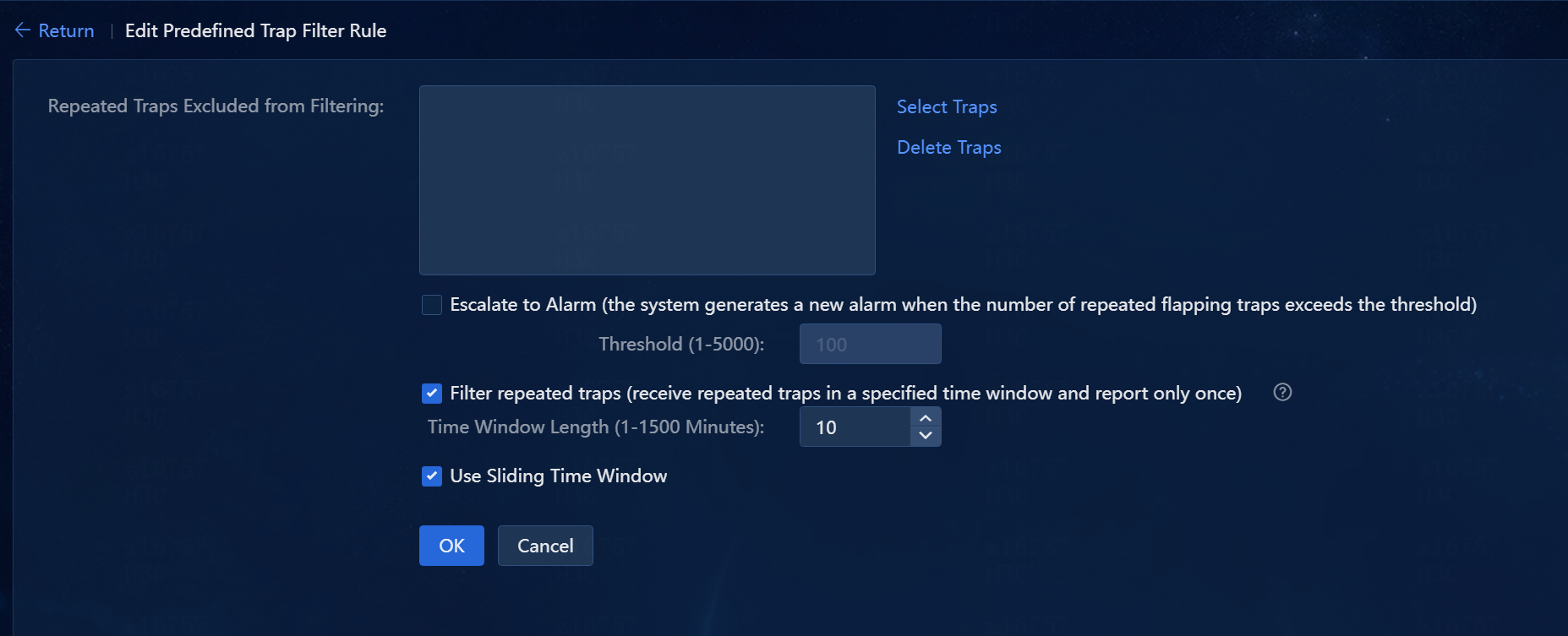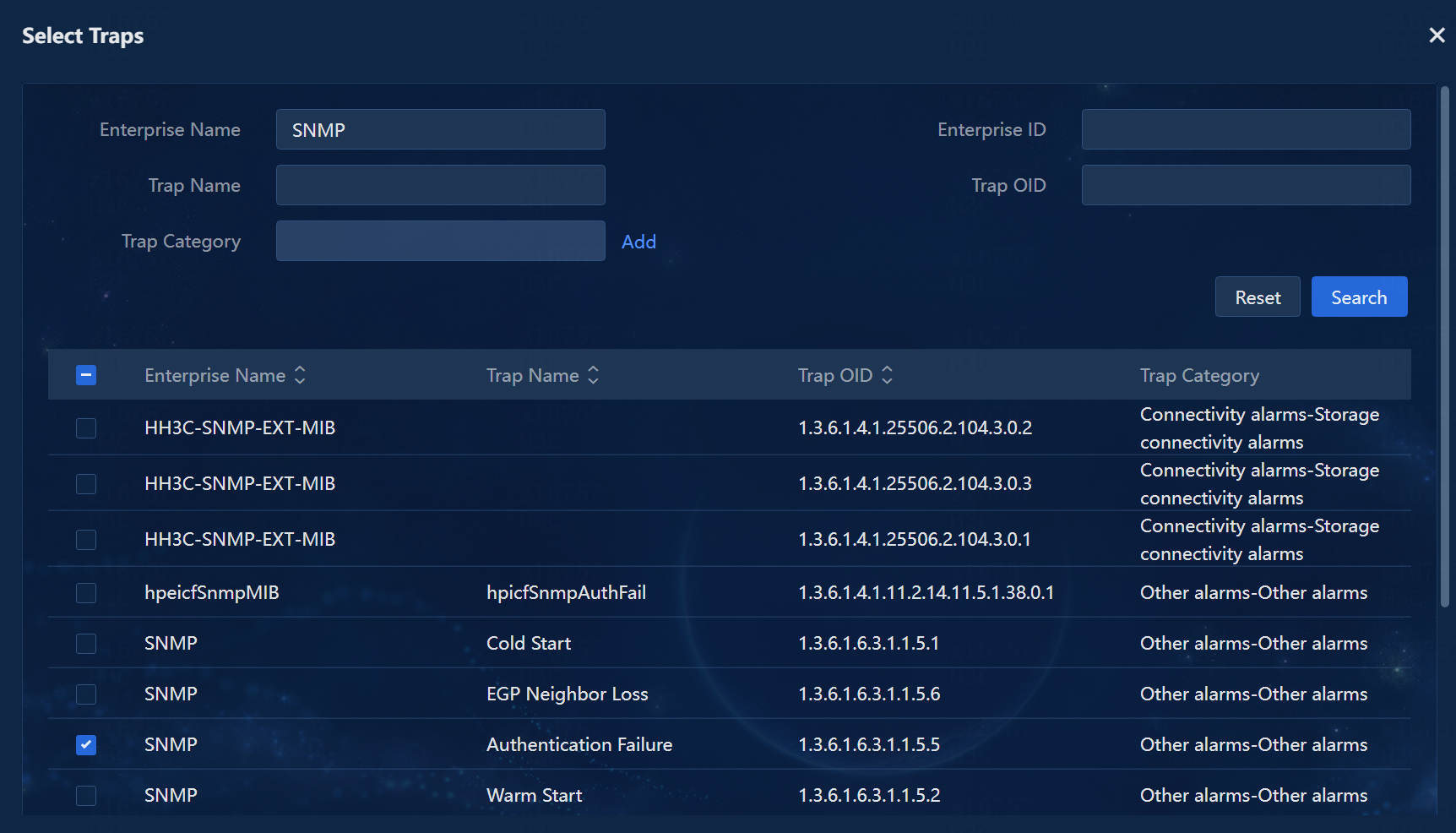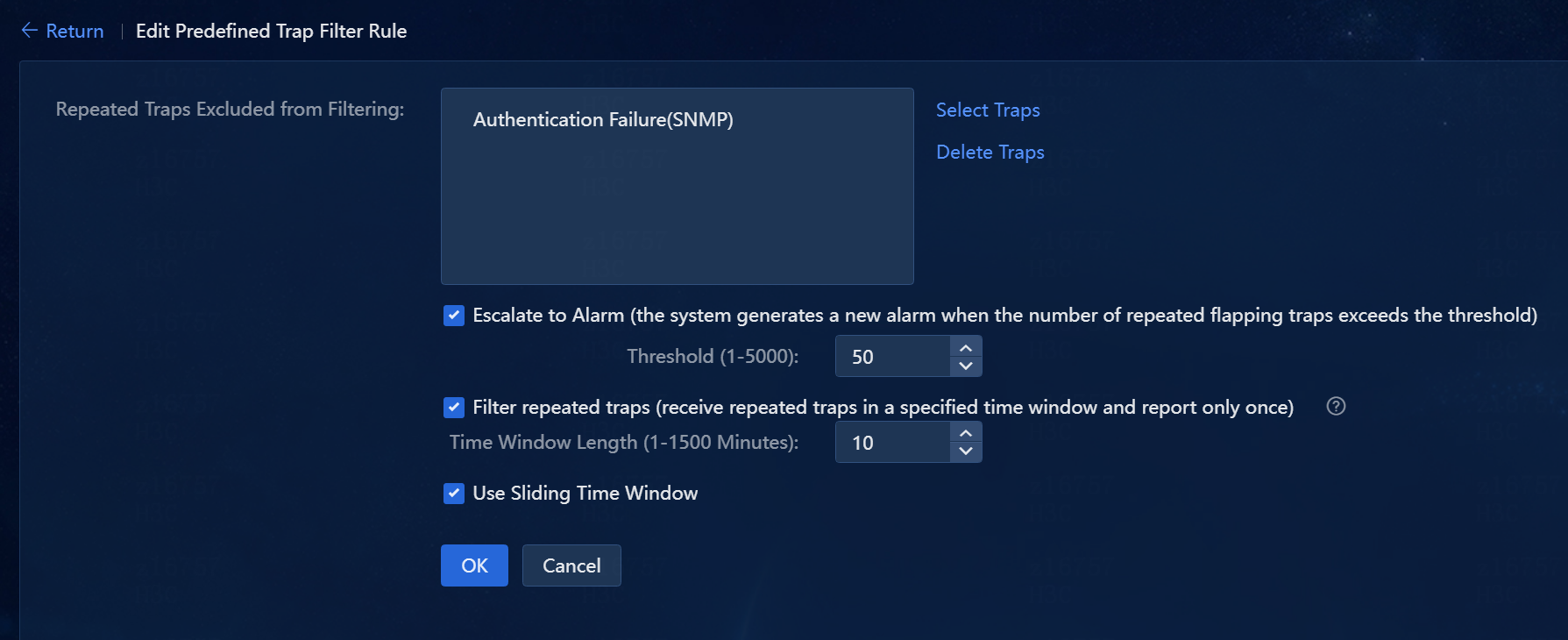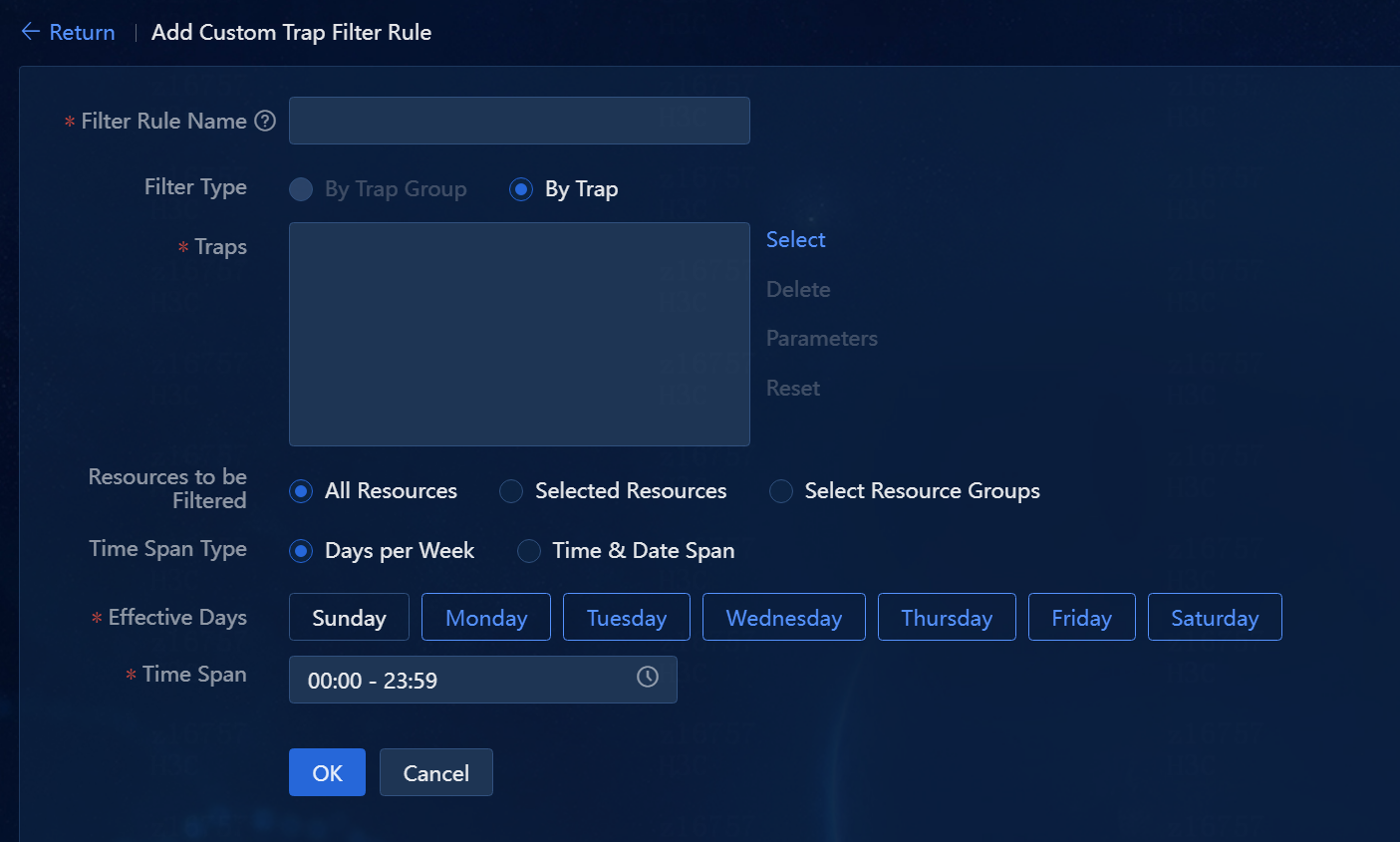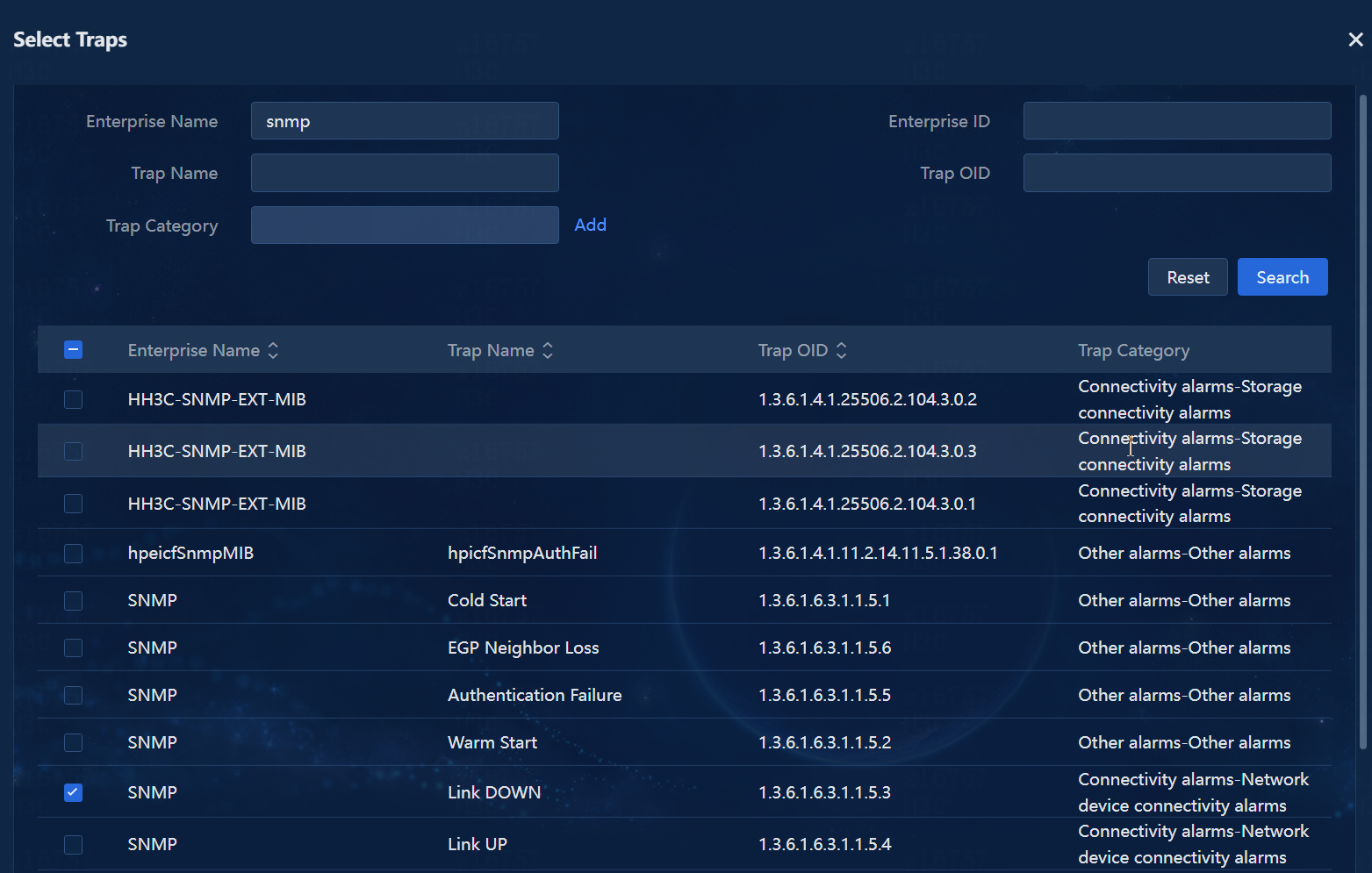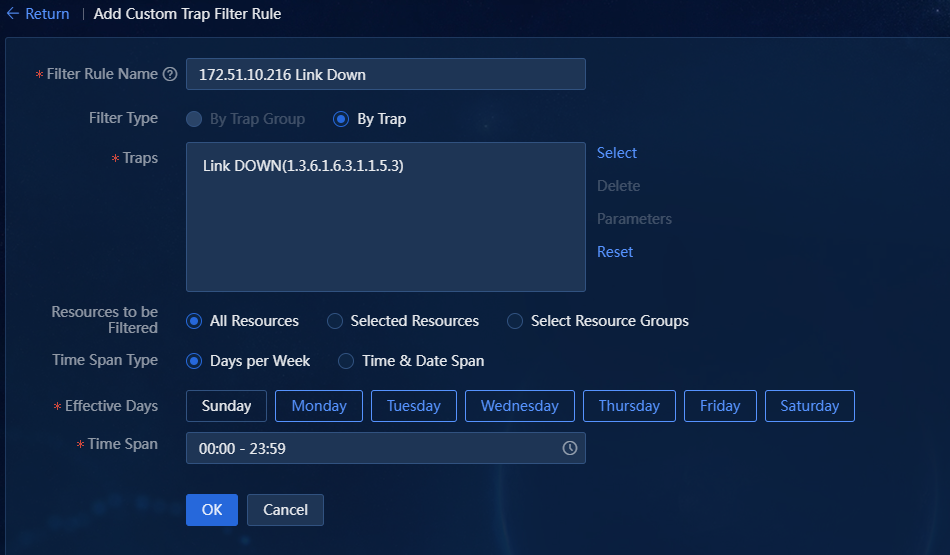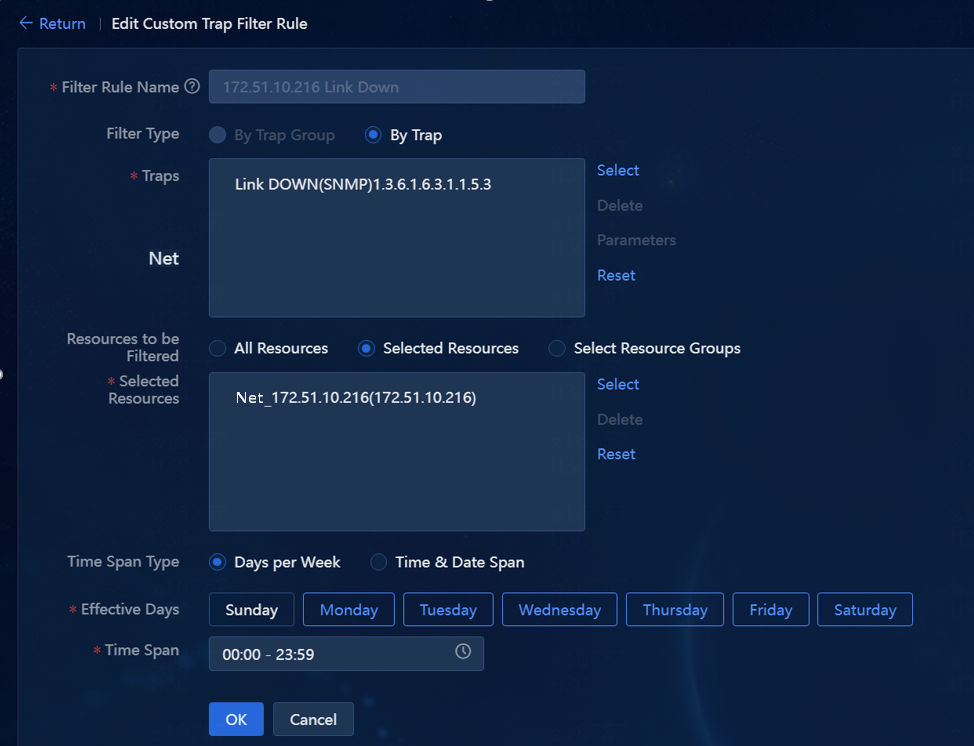- Table of Contents
-
- H3C Unified Platform Configuration Examples-E71xx-5W101
- 01-Unified Platform Operator Permission Management Configuration Examples
- 02-Unified Platform Dashboard Configuration Examples
- 03-Unified Platform Trap Filter Rule Configuration Examples
- 04-Unified Platform Trap-to-Alarm Rule Configuration Examples
- 05-Unified Platform Alarm Forwarding via SMS Configuration Examples
- 06-Unified Platform Alarm Aggregation Configuration Examples
- 07-Unified Platform Component License Registration and Expansion Configuration Examples
- 08-Unified Platform Alarm Forwarding via Mail Configuration Examples
- 09-Unified Platform Two-Factor Authentication Configuration Examples
- 10-Unified Platform Alarm Rendering Configuration Examples
- 11-Unified Platform Syslog Configuration Examples
- Related Documents
-
| Title | Size | Download |
|---|---|---|
| 03-Unified Platform Trap Filter Rule Configuration Examples | 783.73 KB |
Unified Platform Trap Filter Rule
Configuration Examples
Document version: 5W100-20250425
Product version: E7101
Copyright © 2025 New H3C Technologies Co., Ltd. All rights reserved.
No part of this manual may be reproduced or transmitted in any form or by any means without prior written consent of New H3C Technologies Co., Ltd.
Except for the trademarks of New H3C Technologies Co., Ltd., any trademarks that may be mentioned in this document are the property of their respective owners.
The information in this document is subject to change without notice.
Introduction
Based on the trap filter rules, Unified Platform can filter a large number of traps generated on the network and allows you to receive only the concerned traps. This feature improves the trap values and manageability, and improves the performance of the alarm server. Unified Platform has predefined the following trap filter rules:
· Undefined trap filter—An undefined trap refers to a trap whose OID has not yet been defined in the system. After the undefined trap filter is enabled, the system drops the undefined traps received.
· Repeated trap filter—When the system receives a trap, the system identifies whether a trap from the same device and with the same parameters has been received. If yes, the system drops the newly received trap, and stops analyzing or processing the trap. When the number of repeated traps exceeds the specified threshold, the system generates an alarm and sends it to the user.
· Flapping trap filter—A flapping trap means that an abnormal state resumes normal in a short time. After flapping trap analysis is enabled, the system analyzes the received flapping traps. When the specified threshold is reached, the system generates an alarm.
· Unmanaged trap filter—Unmanaged traps refer to traps generated by resources not added to the system. After the unmanaged trap filter is enabled, the system drops the traps from unmanaged devices.
Moreover, you can define filter rules as needed. The following information describes how to configure trap filter rules on Unified Platform in an example.
Prerequisites
If the trap filtering type is by trap group, first configure trap groups.
Example: Configuring trap filter rules
Network configuration
A company uses Unified Platform to manage the network. The topology of the network in the company is as shown in Figure 1. The operator needs to meet the following two requirements during the company network management process:
· In the network managed by Unified Platform, if a device reports the same trap more than 50 times within 10 minutes, Unified Platform will generate only one alarm for that trap and filter out other repeated traps except for SNMP authentication failure traps.
· Filter out all link down traps from the device at IP address 172.51.10.216.
Figure 1 Topology of the network in the company
Analysis
|
Analysis |
|
|
Edit the predefined trap filter rule |
Edit the predefined trap filter rule as needed. |
|
Add a custom trap filter rule |
1. Select the traps to be filtered. 2. Select the resources to be filtered. 3. Set the time span type. |
Software versions used
This configuration example was created and verified on Unified Platform E71xx.
Procedures
Editing the predefined repeated trap filter rule
1. Log in to Unified Platform as an administrator.
2. Navigate to the Alarm > Alarm config > Trap Filter page as shown in Figure 2. The trap filter rule list displays all the trap filter rules in the system.
Figure 2 Trap filter rule list
3. Click the Edit
icon ![]() in
the Actions column for the repeated trap filter
rule on the trap filter rule list. The page for editing the rule opens, as
shown in Figure 3.
in
the Actions column for the repeated trap filter
rule on the trap filter rule list. The page for editing the rule opens, as
shown in Figure 3.
Figure 3 Editing the predefined trap filter rule
4. Select repeated traps excluded from filtering.
a. Click the Select Traps link. The Select Traps page opens.
b. Enter SNMP in the Enterprise Name field, and click the Search button to search for traps containing SNMP in their enterprise names.
c. Select the Authentication Failure trap, as shown in Figure 4.
Figure 4 Selecting repeated traps excluded from filtering
d. Click OK to save repeated traps excluded from filtering, as shown in Figure 5. After configuration, the system will not filter repeated SNMP authentication failure traps.
Figure 5 Excluding Authentication Failure (SNMP) traps from filtering
5. Configure other parameters as follows:
¡ Escalate to Alarm: With this option selected, the system generates a new alarm when the number of repeated traps received exceeds the specified threshold.
¡ Threshold (1- 5000): With the Escalate to Alarm option selected, you can set the threshold. The system generates a new alarm when the number of repeated traps received within the specified time exceeds the threshold. In this example, set the threshold to 50. When a device reports the same trap more than 50 times within the specified time window, the system generates only one alarm for that trap.
¡ Filter Repeated Traps: With this option selected, the repeated traps (except SNMP authentication failure traps selected in repeated traps excluded from filtering) received within the specified time window are reported only once.
¡ Time Window Length (1-1500 Minutes): After you select to use the sliding time window, you can configure the time window length. The repeated traps received within the specified time window are reported only once. In this example, set the time window length to 10 minutes. Then, only one trap will be retained for repeated traps received within 10 minutes.
¡ Use Sliding Time Window: Select this option to use the sliding time window. If you do not select this option, a fixed time window is used.
The configuration result is as shown in Figure 6.
Figure 6 Configuring the repeated trap filter
6. Click OK to complete editing the trap filter rule.
|
|
NOTE: You can configure repeated traps excluded from filtering, time window length, and using the sliding time window only after you select Escalate to Alarm or Filter Repeated Traps, or both. |
Adding a custom trap filter rule
Trap filter rules support filtering by trap group and by trap. This section uses filtering by trap as an example.
To filter traps by trap group, first select traps and configure trap groups from the Alarm > Alarm config > Trap Definitions > Trap Groups menu, and then select a configured trap group on the custom trap filter rule configuration page. Configure a trap filter by trap group in the same way a trap filter by trap is configured.
· By Trap Group: If you select this option, this filter rule filters traps of the selected trap group.
· By Trap: If you select this option, this filter rule filters the specified trap.
To add a custom filter rule by trap:
1. Click Add above the trap filter rule list to access the Add Filter Rule page as shown in Figure 7.
Figure 7 Adding a custom filter rule
2. Enter the filter rule name, a string of up to 32 characters. In this example, enter 172.51.10.216 Link Down.
3. Select the traps to be filtered.
a. Click the Select link next to the Traps field to access the Select Traps page.
b. Enter snmp in the Enterprise Name field, and click the Search button to search for traps containing snmp in their enterprise names.
c. Select the link down trap, as shown in Figure 8.
d. Click OK.
Figure 9 Selected the traps to be filtered successfully
4. Select the resources to be filtered.
¡ All Resources: If you select this option, this filter rule filters traps of all resources.
¡ Selected Resources: If you select this option, this filter rule filters traps of the specified resources.
¡ Selected Resource Groups: If you select this option, this filter rule filters traps of the specified resource groups.
In this example, select the Selected Resources option.
a. Select Selected Resources.
b. Click the Select link. Then, select the device at IP address 172.51.10.216 in the window that opens, as shown in Figure 10.
c. Click OK to save the selected resources.
The system will filter all link down traps from the device at IP address 172.51.10.216.
5. Set the time span type.
Time Span Type: Options include Days per Week and Time & Date Span. The trap filter rule will take effect within the specified time span. In this example, use the system default settings, as shown in Figure 11.
Figure 11 Selected resources successfully
6. Click OK to complete adding the custom filter rule, as shown in Figure 12.
Figure 12 Added the custom filter rule successfully



